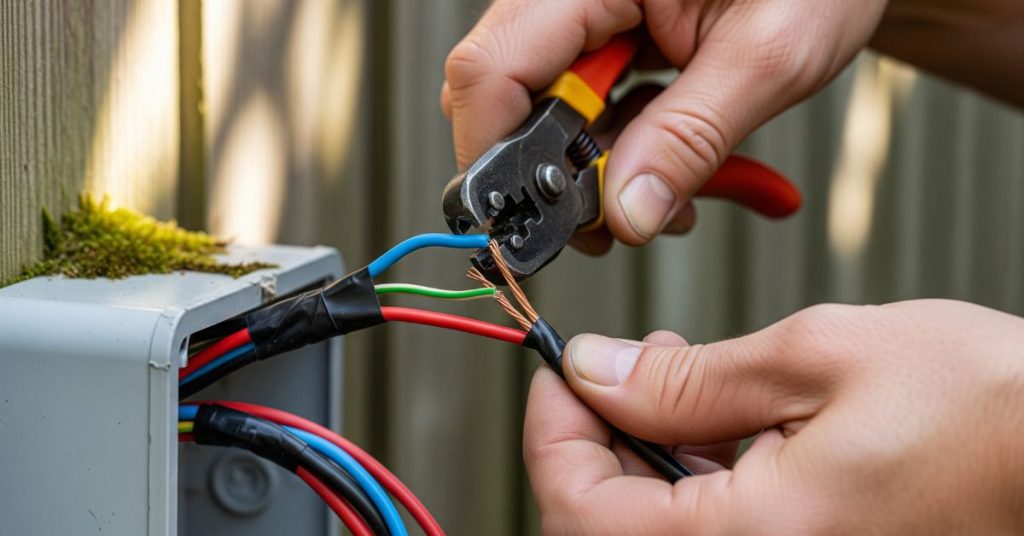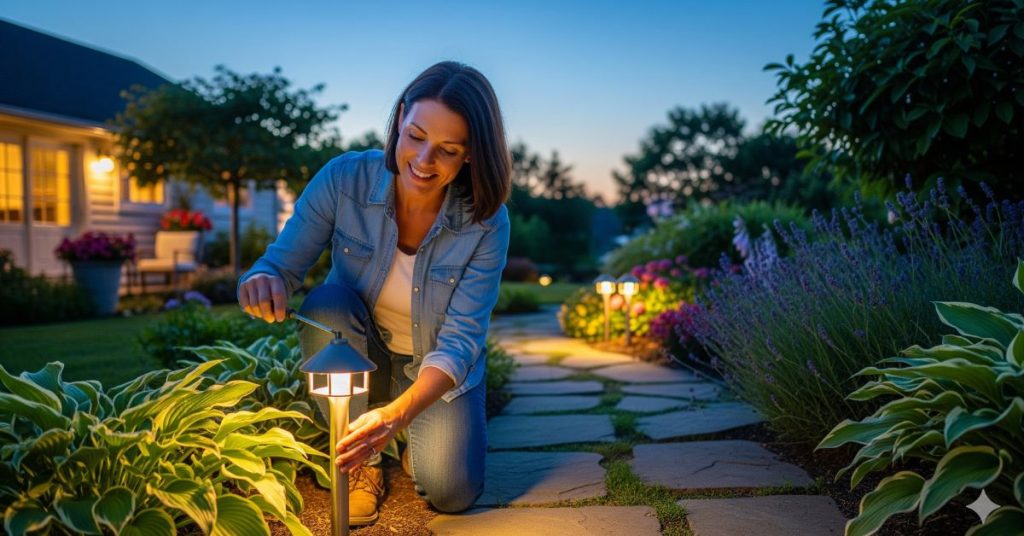As the days grow shorter and the nights stretch longer, autumn becomes the critical season for outdoor lighting repairs. With falling leaves, wetter weather, and earlier sunsets, now is the perfect time to ensure your exterior lights are in top shape. From flickering bulbs to damaged fixtures, addressing these issues promptly can improve safety, enhance curb appeal, and save on energy costs. This guide covers the essential outdoor lighting repair autumn tasks every homeowner should tackle before winter arrives.
Why Autumn is the Ideal Time for Outdoor Lighting Repairs
Autumn is the ideal time for outdoor lighting repairs because it strikes a balance between summer’s heat and winter’s harshness. Milder temperatures make it safer and more comfortable to inspect, clean, and repair lighting systems. With daylight hours decreasing, outdoor lights are used more frequently—for evening visibility, safety, and seasonal decorations.
Addressing issues now ensures your lighting performs reliably when it’s needed most. By preparing in autumn, homeowners avoid emergency fixes during winter’s freezing temperatures and enjoy well-lit, welcoming outdoor spaces.
1. Inspect and Replace Faulty Bulbs
Burnt-out or dimming bulbs reduce visibility and compromise security. Start your autumn maintenance by:
- Walking your property at dusk to identify dark spots or flickering lights.
- Replacing incandescent or halogen bulbs with energy-efficient LED alternatives, which perform better in colder temperatures.
- Ensuring all bulbs are the correct wattage and color temperature for consistent illumination and ambiance.
✅ Pro Tip: Use warm white (2700K–3000K) LEDs for residential walkways and patios to create a cozy and inviting atmosphere during fall evenings.
💡For additional guidance on selecting energy-efficient lighting and understanding wattage options, the U.S. Department of Energy offers a helpful guide on outdoor lighting.
2. Check for Corroded or Damaged Fixtures
Autumn rains and humidity can accelerate corrosion in lighting fixtures, especially older ones made of metal or untreated materials. Be sure to:
- Examine light fixtures for rust, cracks, or water intrusion.
- Tighten loose fittings and replace weather-damaged gaskets or seals.
- Consider upgrading to corrosion-resistant materials, such as brass, copper, or powder-coated aluminum, for longevity.
Visual inspection combined with physical testing (wiggling fixtures, opening housings) is essential for catching early signs of wear before they become expensive problems.
3. Clean All Lenses and Covers
Over time, dust, debris, insect nests, and water spots accumulate on light lenses and covers, significantly reducing brightness and light distribution. To restore optimal illumination:
- Remove the lens covers and clean thoroughly with a non-abrasive cloth and mild soap solution.
- Eliminate any mineral buildup using vinegar or specialized lens cleaner.
- Ensure lenses are dry and properly sealed when reassembled to prevent moisture ingress.
Clean lighting doesn’t just look better—it also enhances the safety and functionality of your property at night.
4. Repair or Replace Exposed Wiring

Exposed or frayed wires are more than unsightly—they’re a serious safety hazard. During autumn, falling branches, rodents, or garden tools can easily damage low-voltage wiring systems. We recommend:
- Inspecting all above-ground and in-ground wiring for cuts, frays, or disconnected ends.
- Using weatherproof connectors and underground-rated cable for any replacements.
- Hiring a licensed electrician for complex or high-voltage repairs to ensure code compliance and safety.
⚠️ Always follow safety protocols when dealing with outdoor wiring. Refer to OSHA’s electrical safety guidelines to better understand the risks and precautions required when working with exposed or damaged electrical components.
Taking preventive action now can help avoid outages and electrical hazards once winter weather sets in.
5. Adjust Lighting Angles for Longer Nights
As the angle of the sun changes and the nights get longer, it’s time to recalibrate your lighting angles for maximum efficiency:
- Realign path lights and uplights for trees, architectural features, or signs to compensate for shifting shadows.
- Ensure motion sensor lights are properly aimed to detect activity across your property.
- Tilt spotlights and floodlights for broader coverage where foot traffic increases in autumn, such as driveways and front doors.
Correctly angled lighting improves security, safety, and aesthetic appeal, particularly during early sunsets and holiday foot traffic.
6. Test and Replace Light Timers and Motion Sensors
Many homeowners forget to reset their timers, dusk-to-dawn sensors, or motion detectors as daylight hours change. This oversight leads to:
- Lights staying on too long or not activating at the right times.
- Increased energy consumption and higher utility bills.
- Reduced security if motion sensors are delayed or nonfunctional.
During your autumn checkup:
- Reset timers to match the earlier sunsets.
- Test motion detectors for responsiveness and replace aging units if detection is delayed or inconsistent.
- Clean sensor lenses and ensure they are free from obstructions, like leaves or spider webs.
7. Upgrade Outdated Fixtures for Efficiency and Style
If your outdoor lighting system is more than 8–10 years old, autumn is a great time to consider upgrading fixtures entirely. A fresh outdoor lighting installation can dramatically improve both efficiency and curb appeal:
- Switch to low-voltage LED systems for energy savings and better performance.
- Choose smart lighting systems with app-based control and automation features.
- Install solar-powered lighting in low-traffic areas to reduce wiring needs and utility costs.
Modern fixtures are often more weather-resistant, energy-efficient, and aesthetically designed to match current architectural trends.
8. Inspect and Repair Landscape Lighting

Landscape lighting is often overlooked but plays a critical role in showcasing your property and ensuring safe navigation. Autumn is the perfect time to focus on landscape lighting repair to keep everything functioning and looking its best:
- Checking in-ground lights for drainage issues or debris.
- Realigning spotlights and accent lighting to highlight seasonal plants, walkways, or garden structures.
- Replacing old halogen landscape bulbs with long-lasting LED options.
Maintaining landscape lighting during autumn guarantees your yard remains inviting, secure, and visually stunning throughout the darker months.
9. Prepare Holiday Lighting Infrastructure
Autumn is the ideal time to prepare your home’s exterior for holiday lighting installations. Avoid last-minute scrambling by:
- Inspecting and repairing outdoor power outlets and extension cords.
- Ensuring GFCI outlets are working properly and protected from moisture.
- Installing hooks, clips, or permanent lighting tracks to simplify and safely support seasonal decor.
- Testing timers and smart plugs to automate your holiday displays and improve energy efficiency.
🎄 To ensure your decorations don’t become a safety hazard, review the CPSC’s holiday lighting safety recommendations, which include tips on using extension cords, GFCI outlets, and weatherproof materials.
By handling these tasks early, you ensure a seamless transition into the festive season without putting strain on your existing lighting system.
10. Conduct a Full System Test Before First Frost
Before the first freeze, perform a complete functionality test of your outdoor lighting:
- Turn on every light during dusk to simulate night conditions.
- Walk the perimeter of your property checking light output, fixture integrity, and timer accuracy.
- Inspect for exposed or damaged wiring that could worsen in freezing temperatures.
- Document any issues and schedule necessary repairs or upgrades before colder weather limits outdoor work.
Preventative testing in autumn is the best defense against winter lighting failures and keeps your outdoor environment functional and beautiful.
Who to Call for Professional Electrical Services Near Me
For reliable and safe outdoor lighting repairs, it’s crucial to contact trusted professionals. The Electricians Service Team offers expert residential electrical services, outdoor lighting maintenance, and electric panel upgrade solutions tailored to your home’s needs. Whether you’re dealing with complex wiring issues or need a complete system upgrade, our licensed electricians ensure quality workmanship and peace of mind. Don’t hesitate to reach out for:
- Expert diagnostics and repairs
- Code-compliant installations
- Preventative electrical maintenance plans
Trust the Electricians Service Team to keep your outdoor lighting shining bright all autumn and beyond.
Final Thoughts: Don’t Wait for Winter to Reveal Your Lighting Issues
Don’t wait for winter to reveal your lighting issues—take action now with essential outdoor lighting repairs to keep your home safe, efficient, and beautiful as the days grow shorter. Autumn’s mild weather offers the perfect window to inspect, clean, and upgrade your lighting before freezing temperatures make repairs more difficult and costly.
Whether it’s a simple bulb replacement or a full lighting system overhaul, professional help ensures lasting results. For expert service and peace of mind, contact us today and let our team keep your outdoor spaces glowing all season long.
FAQs
Autumn provides mild weather, making it easier and safer to inspect and repair outdoor lighting before winter sets in. It also aligns with increased lighting use due to shorter days and upcoming holiday decorations.
At minimum, a full inspection should be done twice a year—ideally in autumn and spring. However, periodic checks after storms or heavy yard work are also recommended.
Yes, in many cases you can swap out halogen or incandescent bulbs for compatible LED versions. However, older systems may benefit from a full fixture upgrade for optimal performance and efficiency.
Look for corrosion, water intrusion, dim or flickering lights, and physical damage to the fixture or wiring. Fixtures older than 8–10 years may also lack energy efficiency and weather resistance.
Basic tasks like bulb replacement or cleaning are safe for most homeowners. For wiring issues, fixture replacements, or anything involving high voltage, it’s best to hire a licensed electrician to ensure safety and code compliance.





